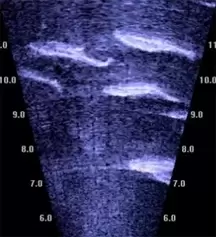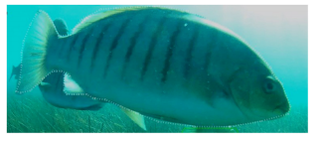Automated Monitoring
Feature publications |
|
Out of the shadows: automatic fish detection from acoustic cameras
Connolly et al. 2023 Aquatic Ecology
Aquatic ecologists can now use computer vision to monitor animals in underwater videos for conservation and management. But what about at night? Or when water is turbid? Well acoustic cameras continue to ‘see’ in these situations. And here we show that FishID software reliably detects and counts fish in imagery from acoustic cameras – especially using their acoustic shadows. This can substantially reduce the time, effort and cost of monitoring with acoustic cameras.
|
|
Automating the analysis of fish abundance using object detection: optimizing animal ecology with deep learning
Ditria et al. 2020 Frontiers in Marine Science
Aquatic ecologists routinely count animals to provide critical information for conservation and management. Increased accessibility to underwater recording equipment such as action cameras and unmanned underwater devices has allowed footage to be captured efficiently and safely, without the logistical difficulties manual data collection often presents. It has, however, led to immense volumes of data being collected that require manual processing and thus significant time, labor, and money.
|
|
Artificial intelligence meets citizen science to supercharge ecological monitoring
McClure et al. 2020 Patterns
Citizen science and artificial intelligence (AI) are often used in isolation for ecological monitoring, but their integration likely has emergent benefits for management and scientific inquiry. We explore the complementarity of citizen science and AI for ecological monitoring, highlighting key opportunities and challenges. We show that strategic integration of citizen science and AI can improve outcomes for conservation activities.
|
Automated monitoring publications
Rod Connolly's publications relating to automated monitoring
2024
2023
2022
2020
2018
2017
- Connolly RM, Herrera C, Rasmussen J, Buelow CA, Sievers M, Jinks KI, Brown CJ, Lopez-Marcano S, Sherman CDH, Martínez-Baena F, Martin B, Baring R, Reeves SE (2024) Estimating enhanced fish production on restored shellfish reefs using automated data collection from underwater videos. Journal of Applied Ecology 61:633-646 PDF
2023
- Connolly RM, Jinks KI, Shand A, Taylor MD, Gaston TF, Becker A, Jinks EL (2023) Out of the shadows: automatic fish detection from acoustic cameras. Aquatic Ecology 57:833-844 PDF
- Kitchingman ME, Sievers M, Lopez-Marcano S, Connolly RM (2023) Fish use of restored mangroves matches that in natural mangroves regardless of forest age. Restoration Ecology 31:13806 PDF
2022
- Connolly RM, Jinks KI, Herrera C, Lopez-Marcano S (2022) Fish surveys on the move: adapting automated fish detection and classification frameworks for videos on a remotely operated vehicle in shallow marine waters. Frontiers in Marine Science 9:918504 PDF
- Ditria EM, Buelow CA, Gonzalez-Rivero M, Connolly RM (2022) Artificial intelligence and automated monitoring for conservation of marine ecosystems: a perspective. Frontiers in Marine Science 9:918104 PDF
- Connolly RM, Fairclough DV, Jinks EL, Ditria EM, Jackson G, Lopez-Marcano S, Olds AD, Jinks KI (2021) Improved accuracy for automated counting of fish in baited underwater videos for stock assessment. Frontiers in Marine Science 8:658135 PDF
- Lopez-Marcano S, Jinks EL, Buelow CA, Brown CJ, Wang D, Kusy B, Ditria EM, Connolly RM (2021) Automatic detection of fish and tracking of movement for ecology. Ecology and Evolution 11:8254-8263 PDF
- Pearson RM, Collier CJ, Brown CJ, Rasheed MA, Bourner J, Turschwell MP, Sievers M, Connolly RM (2021) Remote estimation of aquatic light environments using machine learning: a new management tool for submerged aquatic vegetation. Science of the Total Environment 782:146886 PDF
- Ditria EM, Jinks EL, Connolly RM (2021) Automating the analysis of fish grazing behaviour from videos using image classification and optical flow. Animal Behaviour 177:31-37 PDF
- Provost EJ, Coleman MA, Butcher PA, Colefax A, Schlacher TA, Bishop MJ, Connolly RM, Gilby BL, Henderson CJ, Jones A, Lastra M, Maslo B, Olds AD, Kelaher BP (2021) Quantifying human use of sandy shores with aerial remote sensing technology: the sky is not the limit. Ocean and Coastal Management 211:105750 PDF
- Kimball ME, Connolly RM, Alford SB, Colombano DD, James WR, Kenworthy MD, Norris GS, Ollerhead J, Ramsden S, Rehage JS, Sparks EL, Waltham NJ, Worthington TA, Taylor MD (2021) Novel applications of technology for advancing tidal marsh ecology. Estuaries and Coasts 44:1568-1578 PDF
- Ditria EM, Connolly RM, Jinks EL, Lopez-Marcano S (2021) Annotated video footage for automated identification and counting of fish in unconstrained seagrass habitats. Frontiers in Marine Science 8:629485 PDF
- Lopez-Marcano S, Brown CJ, Sievers M, Connolly RM (2021) The slow rise of technology: computer vision techniques in fish population connectivity. Aquatic Conservation: Marine and Freshwater Ecosystems 31:210-217 PDF
- Mandal R, Becken S, Connolly RM, Stantic B (2021) Residual attention network vs real attention on aesthetic assessment. In: Hong TP, Wojtkiewics K, Chawuthai R, Sitek P (eds) Recent Challenges in Intelligent Information and Database Systems. ACIIDS, Springer, Thailand, pp 310-320 doi:10.1007/978-981-16-1685-3_26 PDF
- Becken S, Friedl H, Stantic B, Connolly RM, Chen J (2021) Climate crisis and flying: social media analysis traces the rise of ‘Flightshame’. Journal of Sustainable Tourism 29:1450-1469 PDF
2020
- Ditria EM, Sievers M, Lopez-Marcano S, Jinks EL, Connolly RM (2020) Deep learning for automated analysis of fish abundance: the benefits of training across multiple habitats. Environmental Monitoring and Assessment 192:698 PDF
- McClure EC, Sievers M, Brown CJ, Buelow CA, Ditria EM, Hayes MA, Pearson RM, Tulloch VJD, Unsworth RKF, Connolly RM (2020) Artificial intelligence meets citizen science to supercharge ecological monitoring. Patterns 1:100109 PDF
- Ditria EM, Lopez-Marcano S, Sievers M, Jinks EL, Brown CJ, Connolly RM (2020) Automating the analysis of fish abundance using object detection: optimizing animal ecology with deep learning. Frontiers in Marine Science 7:429 PDF
- Scott N, Le D, Becken S, Connolly RM (2020) Measuring perceived beauty of the Great Barrier Reef using eye-tracking technology. Current Issues in Tourism 23:2492-2502 PDF
- Graham, A, Marouchos, A, Martini, A, Fischer A, Seet, B-C, Guihen D, Williams G, Symonds, J, Ross D, Soutar, J, Heasman, K, Lea, MA, Leary M, Sikka P, King P, Cossu R, Adams S, Arachillage SJ, Albert S, Cahoon S, Bird S, Connolly RM, Edwards S, Bannister R (2020) Autonomous marine systems at offshore aquaculture and energy sites. Final Report Blue Economy CRC.
- Becken S, Connolly RM, Chen J, Stantic B (2019) A hybrid is born: integrating collective sensing, citizen science and professional monitoring of the environment. Ecological Informatics 52:35-45 PDF
2018
- Mandal R, Connolly RM, Schlacher TA, Stantic B (2018) Assessing fish abundance from underwater video using deep neural networks. IEEE IJCNN 2018:1-6. DOI: 10.1109/IJCNN.2018.8489482 PDF
2017
- Becken S, Stantic B, Chen J, Alaei A, Connolly RM (2017) Monitoring the environment and human sentiment on the Great Barrier Reef: assessing the potential of collective sensing. Journal of Environmental Monitoring 203:87-97 PDF


